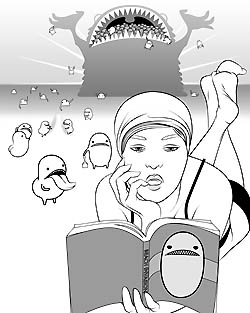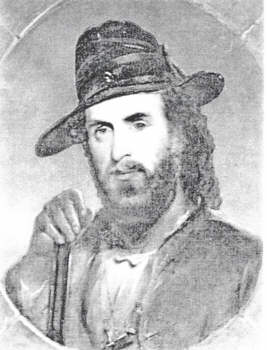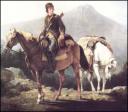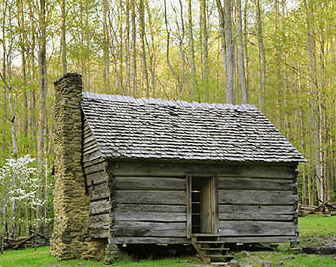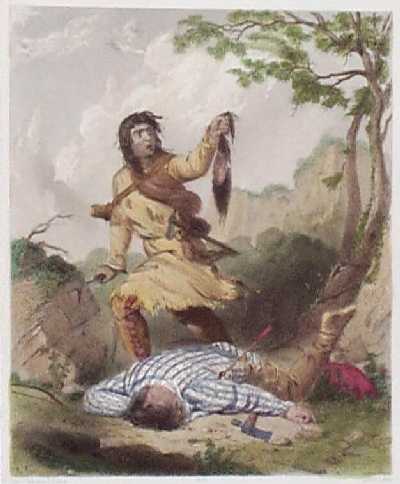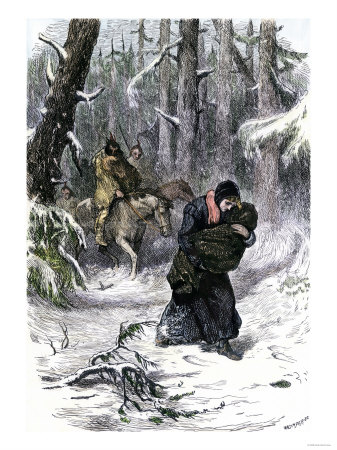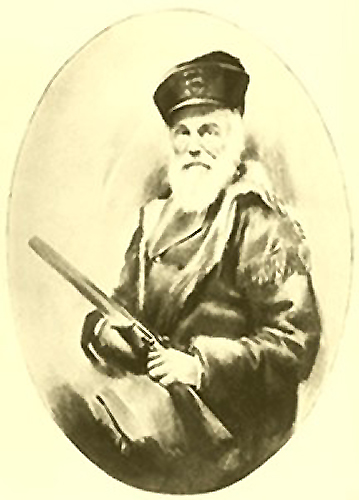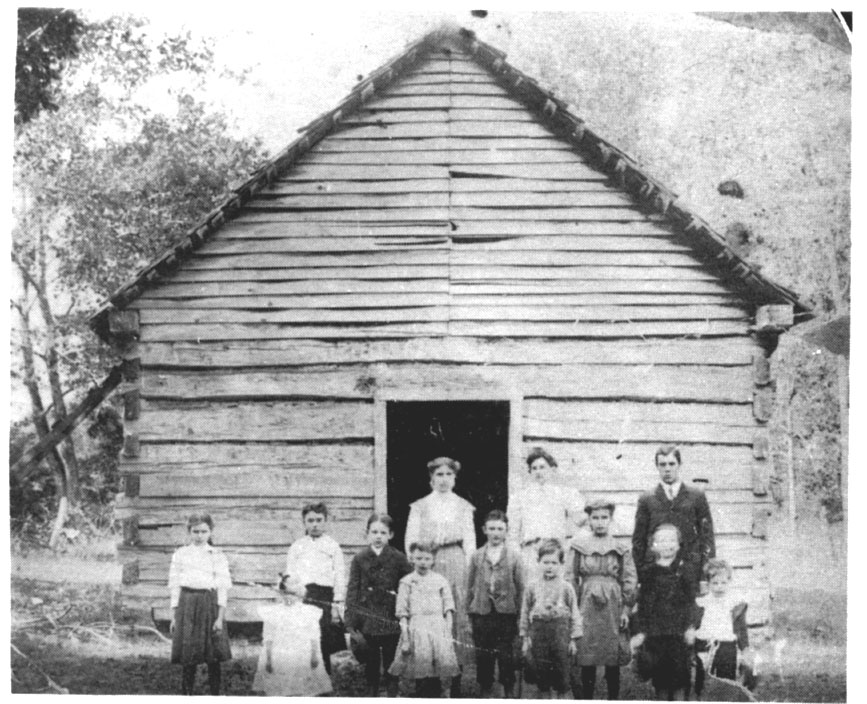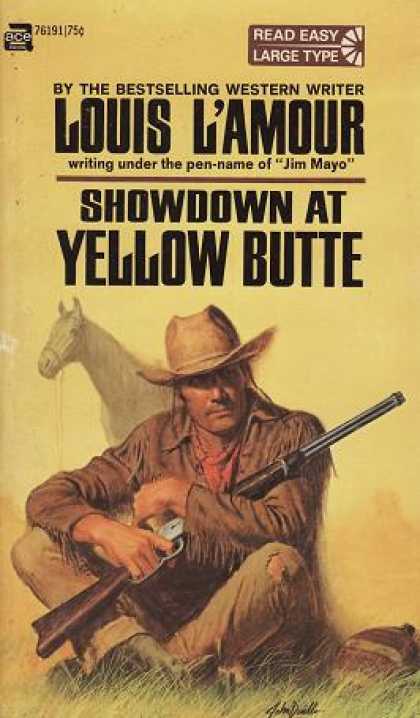|
Irvine Valley College: Online Literature Study of the School of Humanities and Languages Literature 110 - Popular Literature Spring 2013 - Ticket #62740 // Marjorie Coverley Luesebrink, MFA, Instructor
Unit 6b: Cowboy Jamboree Showdown at Yellow Butte, Louis L'Amour The Frontier and Frontier Heroes The frontier in the US can be understood to have begun the day the first colonists set foot on the land and to have ended about 1890.
Joseph Walker - the Last Mountain Man - wearing a real felt beaver hat! From *Westering Man* by Bil Gilbert "A hundred years after the first English-speaking emigrants landed on the Atlantic beaches they, their descendants and newer arrivals had pushed the line of settlement less than 100 miles westward. . . .then, in the next fifty years the remaining three-fourths of what is now the United States was inundated by a raging flood of people." From Fredrick J. Turner's classic text on the Frontier in America:But the larger part of what has been distinctive and valuable in America's contribution to the history of the human spirit has been due to this nation's peculiar experience in extending its type of frontier into new regions; and in creating peaceful societies with new ideals in the successive vast and differing geographic provinces which together make up the United States. Directly or indirectly these experiences shaped the life of the Eastern as well as the Western States, and even reacted upon the Old World and influenced the direction of its thought and its progress. This experience has been fundamental in the economic, political and social characteristics of the American people and in their conceptions of their destiny. Writing at the close of 1796, the French minister to the United States, M. Adet, reported to his government that Jefferson could not be relied on to he devoted to French interests, and he added: "Jefferson, I say, is American, and by that name, he cannot be sincerely our friend. An American is the born enemy of all European peoples." Obviously erroneous as are these words, there was an element of truth in them. If we would understand this element of truth, we must study the transforming influence of the American wilderness, remote from Europe, and by its resources and its free opportunities affording the conditions under which a new people, with new social and political types and ideals, could arise to play its own part in the world, and to influence Europe.....In a recent bulletin of the Superintendent of the Census for 1890 appear these significant words: "Up to and including 1880 the country had a frontier of settlement, but at present the unsettled area has been so broken into by isolated bodies of settlement that there can hardly be said to be a frontier line. In the discussion of its extent, its westward movement, etc., it can not, therefore, any longer have a place in the census reports." This brief official statement marks the closing of a great historic movement. Up to our own day American history has been in a large degree the history of the colonization of the Great West. The existence of an area of free land, its continuous recession, and the advance of American settlement westward, explain American development. FREDERICK J. TURNER.HARVARD UNIVERSITY, March, 1920.
Daniel Boone and the Wilderness. While there are many fictional tales of the first "Westward" explorers, Daniel Boone was a real person. However, the legends that have grown up around his life and exploits began very early on in his career. When Boone was only fifty years old, a sometime schoolteacher, John Filson, wrote a book called "Discovery, Settlement, and Present State of Kentucke." [sic] In this book was a long chapter about Boone: "The Adventures of Col. Daniel Boon" [sic]. This little book was destined to become a classic, was translated into several languages, and the story of Boone was borrowed by several writers in turn. It made Boone famous not only in the US but in London and all over Europe. The chapter on Boone portrays him as a most heroic adventurer - but the large outlines of the account seem to be fairly accurate.
Daniel Boone on horseback It is the legitimate historical truth, though, that interests us as much as the legend in our study of Western Fiction. As we look at the Frontier Heroes, we can see the ways in which the Romance of the American Frontier led directly to the kind of events and value systems that we find in Louis L'Amour's *Showdown at Yellow Butte* and Grey's *Riders of the Purple Sage.* While many analysts, including the author of the Wikipedia article linked above, tend to see the frontier as beginning in the "real west", the notions associated with pioneer settlement go back to the earliest days of settlers on the continent.
A typical pioneer cabin
Boone was part of an incredible migration that began well before the Revolutionary War and continued well into the 20th Century. Boone's Quaker ancestors settled first in Pennsylvania, moved to the western river valleys of Virginia, then went on to North Carolina, and finally, with Daniel, into Tennessee and Kentucky and, finally Missouri. This pattern of migration was mirrored by several different clans of Quaker and "Scotch Irish" families.
James Fenimore Cooper's Frontier Hero in *The Deerslayer*, Natty Bumppo (modeled on Daniel Boone) FYI - a very interesting article on the entire series of Leatherstocking Tales/Bumppo books! That means that, from the late 1600's to the Revolutionary War, there had already been at least three if not more "pioneering" experiences in the same family groups that later moved to Ohio, Indiana, Missouri, and Iowa before 1830. Each time, these families would clear the forest, build a new cabin, plant a crop and gardens, and start a new life in a wilderness (usually close to Native American tribal settlements). It's hard to even imagine how they could have moved so often, taken such risks, and worked so hard! The Frontier Hero was one who could ride and shoot straight, cross mountains and rivers, kill buffalo and bear, build cabins, either befriend or subdue wild Indians, and endure amazing hardships with nary a shudder. His wife could, too - in many cases!
1847 Death Whoop by Seth Eastman. Hand colored steel engraving of Indian scalping a white settler. Drawn by frontier artist Seth Eastman in 1847. Daniel Boone had one of the longest careers among Frontier Heroes - but he is best known for his exploration into Kentucky. The chain of mountains that runs from the Allegheny's down through the Blue Ridge and the Great Smoky Mountains presented a barrier for the Eastern Seaboard colonists for a long time (see above). Boone, although not the first to venture into Kentucky, was the one to discover the "Cumberland Gap" - the gateway that made the journey into Kentucky possible from the Carolinas. He tried to bring his large family and his extended kin to live in Kentucky as early as 1773 - and finally succeeded in 1775. It wasn't long before relations soured with the Shawnee tribe and (!) Boone's daughter, Jemima and her friend, Fanny were kidnapped! Boone immediately set off to rescue them and was successful.
Mrs. Rowlandson and Her Child Taken as Indian Captives in King Philip's War, c.1600. A true story of captivity.
The kidnapping of Boone's daughter was not in any sense the first kidnapping by Native Americans. However, it is instructive for us because right in the middle of the Boone Frontier Hero story we have as central feature the "Captivity Narrative." [As you will see, the double Captivity Narratives of *Riders of the Purple Sage* hold a key role in that novel, as well. During his settlement of Kentucky, Boone distinguished himself as being a peaceful man, cool under pressure, able to find his way through trackless forests, and willing to respect and deal with all manner of people, native and new. {Tom Kedrick, our cowboy hero in *Showdown at Yellow Butte* can be said to be modelled on Boone.}
Frontispiece of Charles Mead's Mississipian Scenery (Philadelphia, 1819). An allegorical grouping of the major symbols of the dream of an agricultural utopia in the Mississippi Valley. The goddess of fertility leans upon the sacred plow. In the background one pioneer fells a tree with the other great Western implement, the axe, while his companion sets about breaking the newly cleared earth. A primitive steamboat in the middle distance suggests future commercial development. This PAGE contains many illustrations from dime novels that give us an idea of how the major themes were seen by bookmakers! Finally, throughout his life, Boone was known to take long "sojourns" into the wilderness by himself. Ostensibly, these were fur trapping and hunting expeditions - but often the Native Americans would intercept him somewhere along the way and take the furs and skins - so the commercial nature of the enterprise was lost. Sometimes these trips would last a few days or a month, other times his lonely wanderings extended to years! Boone claimed that he was making journeys of discovery, and of course he was, but he also said that his time alone in nature was a kind of religion to him. The opening lines of Chapter 3 of *Showdown* echoes this same theme - salvation through isolation in the wilderness. "The magical desert" operates in much the same way as "Kentucky" does in the Boone narratives! Joseph Walker and the West.
Once the mountains had been crossed, settlers moved into Ohio, Indiana, Missouri, Iowa and other Midwest locations with amazing speed. The legendary Frontier Hero of the Woodlands was quickly replaced by a hero of the far west - the Mountain Man. Men such as Kit Carson, Jim Bridger, Jedediah Smith, and Joseph Walker became the new heroes of the farthest reaches. These men were primarily interested in fur trapping and trading - but along the way they had hardships, adventures with the native tribes, and covered (and described) much of the western territory. Walker, especially, was associated with escorting families who wanted to travel to the West - so he forms a kind of bridge between the trapper and the settler. Joseph Walker - was probably the most successful (although lesser known) of the Mountain Men. He represents this kind of hero in many respects. He was calm, brave, resourceful, and had an unerring sense of direction. Like most of the Mountain Men, he did not go into the wilderness to settle a community (although he often led settlers West, as above) - in fact, these men often lived with Indian tribes and married Native American women. The landscape of the West was an inspiration to them, according to their journals, and they braved horrendous physical deprivation to be the first white men to lay eyes on snow-capped mountains, deep river valleys, and vast deserts.
Frontier School in Tenessee In looking at Boone and Walker and our other Frontier Heroes, we can deduce some important themes: Stock Elements of the Frontier Hero Myth The Nature of Sacred Nature: One of the most persistent themes in the myths of the frontier is that of the power of majestic nature, herself. The wilderness was seen in all its Romantic golden-light as a place of ineffable beauty - a place that was inspirational, healing, honest, refreshing, instructional, and closer to God than any other place on earth. For some reason, though, a corollary theme was also the subjugation of nature. Nature in "the raw" was seen to be much like a wild woman that needed to be subdued and mastered. We find both threads running through the frontier narratives.
Mount Moran in the Grand Tetons The Concept of Manhood: The man of the wilderness and the man of the west were molded along the lines of Boone and Walker. This hero is a special breed. The basic traits are simplicity, honesty, and good will. His strengths are not the strengths of the "city man" in any sense. He doesn't need an education (although many of these men were educated, or at least could read and write). He doesn't need fine clothes, a title, or important connections. His church is the great outdoors - where he can commune with an infinite spirit. He is kind and loving to women and children and helpful to all who are in difficulty. He is a loyal companion and shows up when and where he has promised to show up. He does not shrink from hardship or adversity, but he enjoys the simple pleasures of life when he can. He is an idealist - and believes there is a great future ahead in the West. The Interaction with Native Americans: He may fight Indians when there is no other choice, but in the main he defends them, understands them, and might even prefer their villages to civilization. He has come to know the Indian ways well enough to survive in the wilderness on his own, and he readily attests to the value of what he has learned from Native Americans. [In *Showdown at Yellow Butte* we don't have much emphasis on this aspect of the Western Hero - but it is important in many other Cowboy stories!]
Continue to next page - to Unit 6c More about *Showdown at Yellow Butte*
Western: Louis L'Amour. Here is his bio page: http://www.louislamour.com/aboutlouis/biography.htm. The page includes links to lists of titles.
Marjorie Coverley Luesebrink: write to me with questions!
Marjorie Coverley Luesebrink, MFA, your Instructor, is a Professor of English in the School of Humanities and Languages, Irvine Valley College, Irvine, California. See Online writing at Home Page. |
| MENUBAR: About Your Class // Class Syllabus // Lecture Notes // Reading List // Recommended Reading // Assignments // Grading Policies // Contact Your Instructor // Announcements // Discussion |
